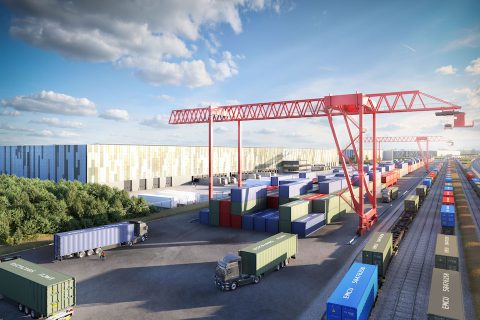Here are 5 differences between EU and US rail freight

In the US, one seems to be able to make money with rail freight. In the EU, this would be a dream coming true. With this statement, the scene was set during the RailFreight webinar EU vs US, Synergies and Differences this morning. RailGood director Hans-Willem Vroon, who uttered these words and transport analyst of Ecorys Onno de Jong each pointed to the crucial differences between rail freight in both continents.
The mini-event was attended by a delegation of the Denver University, students that are enrolled in an Executive MBA and with management positions in transport companies. They listened carefully as the speakers summed up several differences between the US and the EU. We have listed the five most important differences.
Commercial vs public market
“In the US, rail freight companies make it to the stock market”, said de Jong. In the EU, this is a rare occasion and if a rail freight company were listed, I would not put my money there. As a private company, it is not easy to make a profit in the industry.”
Vroon added to this that the situation is entirely different for public companies, and this is in part the reason for the harsh economic climate for private companies. Public companies have a lot of power in the EU. They are often supported with state aid, which creates an unlevel playing field. In the US, commercial companies dominate the market.”
Railroads vs multimodal
Another big difference is the available infrastructure of both continents, which has a lot to do with geographical features. In the US, rail freight mostly moves between east and west on a transport network that consists mostly of railways. In the EU, the main axis runs from north to south, and in most of the countries there is a network of inland waterways”, de Jong describes.
“Inland waterways are a very strong competition for rail freight, especially on the north-south axis. There is a good network of waterways in countries such as the Netherlands and Germany, for example.
Accurate timetable vs congested network
A freight running in time is somewhat of an illusion in the EU, whereas it is much more likely in the US. EU freight trains are renowned for their permanent and often long delays, a reputation that the US freight trains do not seem to have.
This is, explains Vroon, because in the EU freight needs to compete for space with passenger traffic. In most countries, freight trains run on a mixed network, and passenger traffic is almost always prioritised, he explains. “Freight trains must fit into the cadence of the passenger train timetable. In the US, freight trains are prioritised.”
High vs lower volumes
There is also a difference in volumes to be transported by trains, explains de Jong. The demand for rail freight in the US is much higher than in the EU. According to the consultant, this can partly be explained by the active mining industry in the US.
“In the EU, a lot of mines have closed in the past years. This has also had an impact on the rail feight volumes. In the US, the mining industry is still very active, and this stimulates the demand for rail freight transportation”, he noted.
Good vs bad reputation
Last but not least, there is a major difference in the reputation that rail freight holds. This reputation is not very good in the EU. “For example in the Netherlands, people have been protesting against the Noordtak, the northern branch of the freight-dedicated Betuweroute. It is not wanted in this part of the country.”
Vroon agrees. There is always something people complain about. “Trains are too noisy, they cause vibrations or they do not fit in the landscape”, he gives as examples. The environmental benefits are often forgotten. “In the US, there is different public image of rail freight”, concludes de Jong.
You just read one of our premium articles free of charge
Want full access? Take advantage of our exclusive offer





